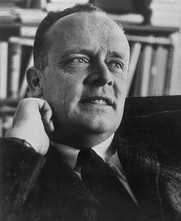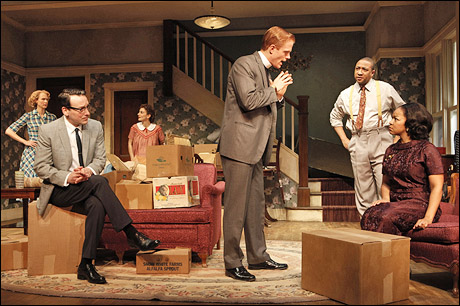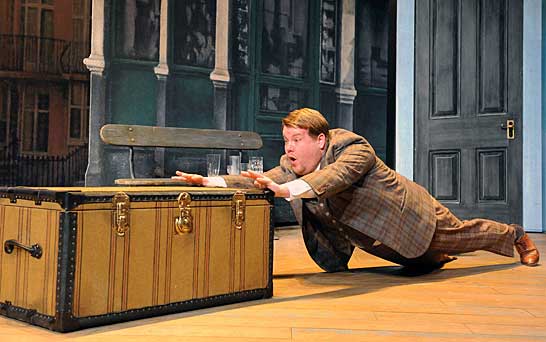“All sins have their origin in a sense of inferiority, otherwise called ambition.”
Cesare Pavese, This Business of Living
Archives for April 2012
TT: The other O’Connor
When the Pulitzer Prize board declined the other day to award a prize this year for fiction, John Williams of the New York Times suggested that it might be a good time to revisit some of the forgotten Pulitzer-winning novels of the past. One of the books he cited was Edwin O’Connor’s The Edge of Sadness, which won in 1962. It happens to be one of my favorite American novels, and in 2009 I wrote an essay about the book for National Review. The piece never appeared on line, so I thought I’d post a shortened version today for your consideration.
* * *
The O’Connor everyone remembers is Flannery, who wrote herself into the history of American literature by looking at the poor white Protestants of her native Georgia through the X-ray glasses of Roman Catholic dogma. But there was another Catholic novelist named O’Connor at work in the Fifties and Sixties, and for a time he was both better known and vastly more popular than his opposite number.
 Edwin O’Connor first rang the gong of success with The Last Hurrah, a 1956 novel about an aging Boston politician that added a phrase to the English language and made the man who coined it rich and famous. Like his opposite number in the Deep South, O’Connor was a devout, wholly orthodox Catholic, a daily communicant who stuck close to home, settling in Boston and writing about the people whom he saw there every day. But unlike the prickly author of Wise Blood and A Good Man Is Hard to Find, the other O’Connor, who died in 1968, had the gift of immediate accessibility, and readers in every corner of the land reveled in his stories of Irish-American life in mid-century New England. The Edge of Sadness, his 1961 tale of an alcoholic priest, was chosen by the Book-of-the-Month Club, condensed by Reader’s Digest, and awarded a Pulitzer Prize. Not surprisingly, it was also one of the top ten best sellers of the year, sharing the list with The Agony and the Ecstasy, Franny and Zooey, and To Kill a Mockingbird.
Edwin O’Connor first rang the gong of success with The Last Hurrah, a 1956 novel about an aging Boston politician that added a phrase to the English language and made the man who coined it rich and famous. Like his opposite number in the Deep South, O’Connor was a devout, wholly orthodox Catholic, a daily communicant who stuck close to home, settling in Boston and writing about the people whom he saw there every day. But unlike the prickly author of Wise Blood and A Good Man Is Hard to Find, the other O’Connor, who died in 1968, had the gift of immediate accessibility, and readers in every corner of the land reveled in his stories of Irish-American life in mid-century New England. The Edge of Sadness, his 1961 tale of an alcoholic priest, was chosen by the Book-of-the-Month Club, condensed by Reader’s Digest, and awarded a Pulitzer Prize. Not surprisingly, it was also one of the top ten best sellers of the year, sharing the list with The Agony and the Ecstasy, Franny and Zooey, and To Kill a Mockingbird.
Such popularity is not easily forgiven in certain cultural circles. Edmund Wilson, who knew O’Connor and admired him greatly, observed apropos of The Edge of Sadness that “a literary intellectual objects to nothing so much as a best-selling book that also possesses real merit.” Small wonder that the book in question, like its author, is now all but forgotten…
Hugh Kennedy, the narrator of The Edge of Sadness, is a fifty-five-year-old priest from a city not unlike Boston who has just climbed back up from the end of his rope. Sent into an emotional tailspin by the death of his beloved father, he takes to drink and is sent to an Arizona retreat for wayward priests, there to grapple with a spiritual emptiness that has left him vulnerable to depression in the middle of life….
The self-effacing Father Kennedy starts off by informing the reader that the story we are about to hear is not about him: “I am in it–good heavens, I’m in it to the point of almost never being out of it!–but the story belongs, all of it, to the Carmodys, and my own part, while substantial enough, was never really of any great significance at all.” The Carmodys are a well-to-do family that Father Kennedy knew and loved as a boy and whose irascible octogenarian patriarch takes a renewed interest in him after he returns to Boston to pick up the pieces of his life. Charlie Carmody and his children, each one representing a different facet of the immigrant experience, are drawn with striking vividness and sympathy, so much so that it is not until well into The Edge of Sadness that we realize that the author has contrived to throw us off the scent: his real subject, it turns out, is not the Carmodys but Father Kennedy’s painful journey from the slough of despond to the brink of renewal….
In The Living Novel, V.S. Pritchett praised those novelists “who are not driven back by life, who are not shattered by the discovery that it is a thing bounded by unsought limits, by interests as well as by hopes, and that it ripens under restriction. Such writers accept. They think that acceptance is the duty of a man.” Pritchett was talking about Walter Scott, but he could just as well have had The Edge of Sadness in mind, for it is above all a story of acceptance, a portrait of a group of men and women who find themselves forced at last to face the fact that their dreams will not come true….
Yet the closing pages of The Edge of Sadness are also suffused with the warm glow of possibility, and never for a moment does it have the factitious feel of a confidence trick played by a best-selling author determined to send his audience home happy. For even though Father Kennedy continues to believe in “the essential goodness of man,” he also knows that “only a fool can look around him and smile serenely in unwatered optimism.” He knows, too, that the spiritual dryness that came close to destroying him can only be held at bay if he immerses himself in the daily life of his shabby parish, trading the easy familiarity of his old existence for the awareness that
while something was over forever, something else had just begun–and that if the new might not seem the equal of the old, that might be because the two were not to be compared….that something might be ahead that grew out of the past, yes, but was totally different, with its own labors and rewards, that it might be deeper and fuller and more meaningful than anything in the past.
After The Edge of Sadness, Edwin O’Connor published only one more full-scale novel, All in the Family, which was as popular and artistically successful as its predecessors. But the pace of change in America had sped up between 1961 and 1966, and a new generation of critics who had cut their teeth on high modernism now found little to like in an unselfconsciously old-fashioned storyteller who worshipped the gods of directness and simplicity. Two years after he died, Edmund Wilson and Arthur Schlesinger put together The Best and the Last of Edwin O’Connor, a well-meant anthology that sought in vain to keep his memory green. Denis Donoghue, who wrote about it in The New York Review of Books, declared that O’Connor’s oeuvre was “a public success but still, in the artistic sense, incomplete, his possibilities unfulfilled.”
Perhaps–but to read The Edge of Sadness today is to doubt the finality of that reasonable-sounding judgment. I thought that it was an extraordinarily fine book when I first read it a quarter-century ago, and now that I am almost as old as Father Hugh Kennedy, I think it better still. Few American novels have done a more honest job of telling how it feels for a man to come to the middle of life’s journey, and even fewer have the power to fill their readers with a sense of hope strong enough to be felt not merely in the bright light of day but in the middle of the dark night of the soul.
TT: Just because (in memoriam, Levon Helm)
The Band plays “King Harvest (Has Surely Come)” and “Long Black Veil”:
(This is the latest in a series of arts-related videos that appear in this space each Monday and Wednesday.)
TT: Almanac
“Ambition fortifies the will of man to become ruler over other men: it operates with deception, cajolery, and violence, it is the action of impurity upon impurity.”
T.S. Eliot, Murder in the Cathedral
TT: Minority report
In today’s Wall Street Journal I have nothing very good to say about the Broadway transfer of Bruce Norris’ Clybourne Park. Here’s an excerpt.
* * *
It happens that I was on the road throughout the Off-Broadway run of “Clybourne Park,” and ever since then I’ve been wondering what I missed. Was it really possible that a playwright had finally gotten up the nerve to take an unsparingly honest look at race relations in America? Stranger things have happened–but not this time around. “Clybourne Park” turns out to be a runny egg, a play that pretends to be daring but takes the utmost care not to be too challenging to the assumptions of its viewers.
 As you probably know by now, Mr. Norris’ play is a variation on “A Raisin in the Sun,” Lorraine Hansberry’s 1959 play about the Youngers, a black family that moves to a white neighborhood in Chicago. In the first act of “Clybourne Park,” set in 1959, we meet Bev and Russ (Christina Kirk and Frank Wood), who are selling their house to the Youngers (who are talked about but never seen). Also present and very much accounted for are their black maid (Crystal A. Dickinson), her husband (Damon Gupton), and a group of outraged neighbors who all claim to be good liberals but draw the line at living next door to blacks: “Who shall we invite next, the Red Chinese?”
As you probably know by now, Mr. Norris’ play is a variation on “A Raisin in the Sun,” Lorraine Hansberry’s 1959 play about the Youngers, a black family that moves to a white neighborhood in Chicago. In the first act of “Clybourne Park,” set in 1959, we meet Bev and Russ (Christina Kirk and Frank Wood), who are selling their house to the Youngers (who are talked about but never seen). Also present and very much accounted for are their black maid (Crystal A. Dickinson), her husband (Damon Gupton), and a group of outraged neighbors who all claim to be good liberals but draw the line at living next door to blacks: “Who shall we invite next, the Red Chinese?”
The second act flashes forward to the same house a half-century later. Sure enough, white flight turned Clybourne Park into a crime-ridden ghetto, but one that has since been transformed yet again, this time by the equally inexorable forces of gentrification. Enter Lindsey and Steve (Annie Parisse and Jeremy Shamos), a well-heeled young white couple who want to buy the Younger house and turn it into something bigger, fancier and tackier. This displeases Kevin and Lena (Mr. Gupton and Ms. Dickinson), a buppie couple who are worried about the effect that such a renovation would have on the “historical value” of the neighborhood. What follows is a “God of Carnage”-style free-for-all in which we discover that Lindsey and Steve are just as racially insensitive, albeit in a more genteel way, as their forebears.
What makes the success of “Clybourne Park” so interesting is that American theater is a monoculture, a thick-walled bubble in which you’ll look long and hard to find anyone with an opinion about anything that is anywhere other than well to the left of center. The trouble with monocultures, of course, is that they tend not to encourage self-criticism. Hence it’s always encouraging whenever a playwright dares to take shots at his own side. The bad news is that the comedy in “Clybourne Park” amounts to little more than lazy caricature. This is especially evident in the first act, which is peopled with vapid stick figures who appear to be drawn not from real life but from an Eisenhower-era TV sitcom. If that’s Mr. Norris’ idea of satire, he needs to sharpen his pencil….
* * *
Read the whole thing here.
TT: Almanac
“Deep experience is never peaceful.”
Henry James, “Madame de Mauves”
TT: An extension for Satchmo at the Waldorf
Here’s how busy I’ve been: I completely forgot to pass the word that Shakespeare & Company’s production of Satchmo at the Waldorf, my first play, has already been extended! It opens on August 22 in Lenox, Mass., and will now run there until September 16.
For more information, or to order tickets on line, go here.
TT: For Anglophiles only
Due to the crush of Broadway openings this week and next, I’m filing several extra drama columns for The Wall Street Journal. In today’s paper I report on One Man, Two Guvnors and Peter and the Starcatcher, neither of which did much for me. Here’s an excerpt.
* * *
Spring has come to Broadway, and with it the annual big-ticket British import. This year it’s “One Man, Two Guvnors,” Richard Bean’s Anglicized adaptation of “The Servant of Two Masters,” Carlo Goldoni’s classic 1746 comedy. Don’t be deceived by that description, though, because “One Man, Two Guvnors” is not a highbrow show, or even a “Masterpiece Theatre”-style middlebrow costume drama. It’s a lowbrow vaudeville turn in the manner of “The Benny Hill Show,” and part of the fun–if you’re English, anyway–is that this hot, sweaty, moderately bawdy play has been staged by Nicholas Hytner and is being performed by the National Theatre of Great Britain, which has hitherto favored us with such elevated fare as “The History Boys,” “Jumpers,” “The Pillowman,” “The Pitmen Painters” and, most recently, “War Horse.” It might be easier to appreciate the joke, such as it is, if “One Man, Two Guvnors” were funnier, but it’s a decidedly mixed bag, a very long show (two and a half hours) with one brilliant scene that doesn’t compensate for the acres of tedium that surround it.
 The plot, in which a hapless klutz (James Corden) who works for two different bosses (Oliver Chris and Jemima Rooper) gets himself into a world of trouble, need not concern us, since “One Man, Two Guvnors,” is not a plot-driven farce but a pretext for frenzied slapstack and nudge-nudge-wink-wink dialogue (one of the characters is a lawyer from the firm of “Dangle, Berry and Bush”). The play is set in 1963–the year in which, according to Philip Larkin, sexual intercourse began–and is accompanied by the sort-of-Beatleish songs of a four-man pop combo called the Craze. What we have here, in short, is a style of comedy as culture-specific as the lower-middle-class accents assumed by the members of the excellent cast, and one that has never managed to get much of a toehold in America. It’s as if Lincoln Center Theater were to produce a play about Abbott and Costello and send it to the West End….
The plot, in which a hapless klutz (James Corden) who works for two different bosses (Oliver Chris and Jemima Rooper) gets himself into a world of trouble, need not concern us, since “One Man, Two Guvnors,” is not a plot-driven farce but a pretext for frenzied slapstack and nudge-nudge-wink-wink dialogue (one of the characters is a lawyer from the firm of “Dangle, Berry and Bush”). The play is set in 1963–the year in which, according to Philip Larkin, sexual intercourse began–and is accompanied by the sort-of-Beatleish songs of a four-man pop combo called the Craze. What we have here, in short, is a style of comedy as culture-specific as the lower-middle-class accents assumed by the members of the excellent cast, and one that has never managed to get much of a toehold in America. It’s as if Lincoln Center Theater were to produce a play about Abbott and Costello and send it to the West End….
Except for Cathy Rigby, scarcely anybody in America does “Peter Pan” anymore. J.M. Barrie’s 1904 play is almost never produced on this side of the Atlantic, and the 1954 musical-comedy adaptation concocted by Jerome Robbins, which NBC used to telecast at fairly frequent intervals, was last revived on Broadway in 1999 and vanished from TV long before that. For this reason, it seems unlikely that very many under-40 playgoers will know what’s missing from “Peter and the Starcatcher,” Rick Elice’s stage version of the 2006 novel in which Dave Barry (yes, that Dave Barry) and Ridley Pearson contrived to explain how the winsome flying boy who never wanted to grow up got to Neverland in the first place.
If you’ve never seen “Peter Pan,” then you may well find “Peter and the Starcatcher” amusing in its ultra-contemporary way, but Barrie and Robbins were up to something completely different. The real “Peter Pan” is an ode to lost innocence, one whose whimsy barely disguises its underlying pathos. Not so “Peter and the Starcatcher,” which is reminiscent of nothing so much as the reflexively sarcastic animated cartoons on which the millennial generation cut its baby teeth, in which knowing pop-culture references and catchphrases take the place of actual jokes….
* * *
Read the whole thing here.
From the 1960 telecast of Jerome Robbins’ adaptaion of J.M. Barrie’s Peter Pan, Mary Martin sings “Never Never Land,” by Jule Styne, Betty Comden, and Adolph Green:
